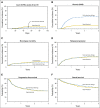Reduced-Intensity Transplantation for Lymphomas Using Haploidentical Related Donors Versus HLA-Matched Sibling Donors: A Center for International Blood and Marrow Transplant Research Analysis
- PMID: 27269951
- PMCID: PMC5012706
- DOI: 10.1200/JCO.2015.66.3476
Reduced-Intensity Transplantation for Lymphomas Using Haploidentical Related Donors Versus HLA-Matched Sibling Donors: A Center for International Blood and Marrow Transplant Research Analysis
Abstract
Purpose: Related donor haploidentical hematopoietic cell transplantation (Haplo-HCT) using post-transplantation cyclophosphamide (PT-Cy) is increasingly used in patients lacking HLA-matched sibling donors (MSD). We compared outcomes after Haplo-HCT using PT-Cy with MSD-HCT in patients with lymphoma, using the Center for International Blood and Marrow Transplant Research registry.
Materials and methods: We evaluated 987 adult patients undergoing either Haplo-HCT (n = 180) or MSD-HCT (n = 807) following reduced-intensity conditioning regimens. The haploidentical group received graft-versus-host disease (GVHD) prophylaxis with PT-Cy with or without a calcineurin inhibitor and mycophenolate. The MSD group received calcineurin inhibitor-based GVHD prophylaxis.
Results: Median follow-up of survivors was 3 years. The 28-day neutrophil recovery was similar in the two groups (95% v 97%; P = .31). The 28-day platelet recovery was delayed in the haploidentical group compared with the MSD group (63% v 91%; P = .001). Cumulative incidence of grade II to IV acute GVHD at day 100 was similar between the two groups (27% v 25%; P = .84). Cumulative incidence of chronic GVHD at 1 year was significantly lower after Haplo-HCT (12% v 45%; P < .001), and this benefit was confirmed on multivariate analysis (relative risk, 0.21; 95% CI, 0.14 to 0.31; P < .001). For Haplo-HCT v MSD-HCT, 3-year rates of nonrelapse mortality (15% v 13%; P = .41), relapse/progression (37% v 40%; P = .51), progression-free survival (48% v 48%; P = .96), and overall survival (61% v 62%; P = .82) were similar. Multivariate analysis showed no significant difference between Haplo-HCT and MSD-HCT in terms of nonrelapse mortality (P = .06), progression/relapse (P = .10), progression-free survival (P = .83), and overall survival (P = .34).
Conclusion: Haplo-HCT with PT-Cy provides survival outcomes comparable to MSD-HCT, with a significantly lower risk of chronic GVHD.
© 2016 by American Society of Clinical Oncology.
Conflict of interest statement
Authors’ disclosures of potential conflicts of interest are found in the article online at www.jco.org. Author contributions are found at the end of this article.
Figures

References
-
- Peniket AJ, Ruiz de Elvira MC, Taghipour G, et al. An EBMT registry matched study of allogeneic stem cell transplants for lymphoma: Allogeneic transplantation is associated with a lower relapse rate but a higher procedure-related mortality rate than autologous transplantation. Bone Marrow Transplant. 2003;31:667–678. - PubMed
-
- Ratanatharathorn V, Uberti J, Karanes C, et al. Prospective comparative trial of autologous versus allogeneic bone marrow transplantation in patients with non-Hodgkin’s lymphoma. Blood. 1994;84:1050–1055. - PubMed
-
- Grewal SS, Barker JN, Davies SM, et al. Unrelated donor hematopoietic cell transplantation: Marrow or umbilical cord blood? Blood. 2003;101:4233–4244. - PubMed
Publication types
MeSH terms
Substances
Grants and funding
LinkOut - more resources
Full Text Sources
Other Literature Sources
Medical
Research Materials

